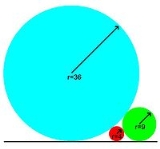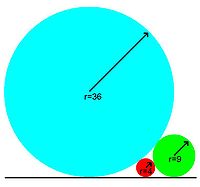
Sangaku
Encyclopedia
Sangaku or San Gaku are Japanese geometrical puzzles in Euclidean geometry
on wooden tablets which were placed as offerings at Shinto shrines or Buddhist temples
during the Edo period
(1603–1867) by members of all social classes.
that followed the Edo period, but around nine hundred are known to remain.
Fujita Kagen (1765–1821), a Japanese mathematician of prominence, published the first collection of sangaku problems, his Shimpeki Sampo (Mathematical problems Suspended from the Temple) in 1790, and in 1806 a sequel, the Zoku Shimpeki Sampo.
During this period Japan
applied strict regulations to commerce and foreign relations for western countries so the tablets were created using Japanese mathematics
, (wasan), developed in parallel to western mathematics. For example, the connection between an integral and its derivative (the fundamental theorem of calculus
) was unknown, so Sangaku problems on areas and volumes were solved by expansions in infinite series and term-by-term calculation.
 A typical problem, which is presented on an 1824 tablet in the Gunma Prefecture
A typical problem, which is presented on an 1824 tablet in the Gunma Prefecture
, covers the relationship of three touching circles with a common tangent
. Given the size of the two outer large circles, what is the size of the small circle between then? The answer is:
(See also Ford circle
.)
, thought previously to have been discovered in the west in 1937, has been discovered on a Sangaku dating from 1822.
Euclidean geometry
Euclidean geometry is a mathematical system attributed to the Alexandrian Greek mathematician Euclid, which he described in his textbook on geometry: the Elements. Euclid's method consists in assuming a small set of intuitively appealing axioms, and deducing many other propositions from these...
on wooden tablets which were placed as offerings at Shinto shrines or Buddhist temples
Buddhist temples in Japan
Along with Shinto shrines, Buddhist temples are the most numerous, famous, and important religious buildings in Japan.The term "Shinto shrine" is used in opposition to "Buddhist temple" to mirror in English the distinction made in Japanese between Shinto and Buddhist religious structures. In...
during the Edo period
Edo period
The , or , is a division of Japanese history which was ruled by the shoguns of the Tokugawa family, running from 1603 to 1868. The political entity of this period was the Tokugawa shogunate....
(1603–1867) by members of all social classes.
History
The Sangaku were painted in color on wooden tablets and hung in the precincts of Buddhist temples and Shinto shrines as offerings to the gods or as challenges to the congregants or publish what question one solved. Many of these tablets were lost during the period of modernizationModernization
In the social sciences, modernization or modernisation refers to a model of an evolutionary transition from a 'pre-modern' or 'traditional' to a 'modern' society. The teleology of modernization is described in social evolutionism theories, existing as a template that has been generally followed by...
that followed the Edo period, but around nine hundred are known to remain.
Fujita Kagen (1765–1821), a Japanese mathematician of prominence, published the first collection of sangaku problems, his Shimpeki Sampo (Mathematical problems Suspended from the Temple) in 1790, and in 1806 a sequel, the Zoku Shimpeki Sampo.
During this period Japan
Japan
Japan is an island nation in East Asia. Located in the Pacific Ocean, it lies to the east of the Sea of Japan, China, North Korea, South Korea and Russia, stretching from the Sea of Okhotsk in the north to the East China Sea and Taiwan in the south...
applied strict regulations to commerce and foreign relations for western countries so the tablets were created using Japanese mathematics
Japanese mathematics
denotes a distinct kind of mathematics which was developed in Japan during the Edo Period . The term wasan, from wa and san , was coined in the 1870s and employed to distinguish native Japanese mathematics theory from Western mathematics .In the history of mathematics, the development of wasan...
, (wasan), developed in parallel to western mathematics. For example, the connection between an integral and its derivative (the fundamental theorem of calculus
Fundamental theorem of calculus
The first part of the theorem, sometimes called the first fundamental theorem of calculus, shows that an indefinite integration can be reversed by a differentiation...
) was unknown, so Sangaku problems on areas and volumes were solved by expansions in infinite series and term-by-term calculation.
Select examples

Gunma Prefecture
is a prefecture of Japan located in the northwest corner of the Kantō region on Honshu island. Its capital is Maebashi.- History :The remains of a Paleolithic man were found at Iwajuku, Gunma Prefecture, in the early 20th century and there is a public museum there.Japan was without horses until...
, covers the relationship of three touching circles with a common tangent
Tangent
In geometry, the tangent line to a plane curve at a given point is the straight line that "just touches" the curve at that point. More precisely, a straight line is said to be a tangent of a curve at a point on the curve if the line passes through the point on the curve and has slope where f...
. Given the size of the two outer large circles, what is the size of the small circle between then? The answer is:
(See also Ford circle
Ford circle
In mathematics, a Ford circle is a circle with centre at and radius 1/, where p/q is an irreducible fraction, i.e. p and q are coprime integers...
.)
In the west
Soddy's hexletSoddy's hexlet
In geometry, Soddy's hexlet is a chain of six spheres , each of which is tangent to both of its neighbors and also to three mutually tangent given spheres. In Figure 1, these three spheres are shown as an outer circumscribing sphere C , and two spheres A and B above and below the plane of their...
, thought previously to have been discovered in the west in 1937, has been discovered on a Sangaku dating from 1822.
See also
- Recreational mathematicsRecreational mathematicsRecreational mathematics is an umbrella term, referring to mathematical puzzles and mathematical games.Not all problems in this field require a knowledge of advanced mathematics, and thus, recreational mathematics often attracts the curiosity of non-mathematicians, and inspires their further study...
- Seki TakakazuSeki Takakazu, also known as , was a Japanese mathematician in the Edo period.Seki laid foundations for the subsequent development of Japanese mathematics known as wasan; and he has been described as Japan's "Newton."...
- Japanese theorem for concyclic polygons
- Japanese theorem for concyclic quadrilateralsJapanese theorem for concyclic quadrilateralsIn geometry, the Japanese theorem states that the centers of the incircles of certain triangles inside a cyclic quadrilateral are vertices of a rectangle....
- Equal Incircles TheoremEqual incircles theoremIn geometry, the equal incircles theorem derives from a Japanese Sangaku, and pertains to the following construction: a series of rays are drawn from a given point to a given line such that the inscribed circles of the triangles formed by adjacent rays and the base line are equal...
External links
- http://www.sangaku.info/
- http://www.wasan.jp/english/
- http://www.loyola.edu/maru/sangaku.html
- An interesting Sangaku problem by Archimedes Laboratory
- http://www2.gol.com/users/coynerhm/0598rothman.html
- Pythagoras and Vecten Break Japan's Isolation
- http://matcmadison.edu/is/as/math/kmirus/Reference/SanGaku.html
- Sangaku: Reflections on the Phenomenon
- East Asia Institute, University of CambridgeUniversity of CambridgeThe University of Cambridge is a public research university located in Cambridge, United Kingdom. It is the second-oldest university in both the United Kingdom and the English-speaking world , and the seventh-oldest globally...
: Further reading/bibliography - http://pagesperso-orange.fr/gery.huvent/html/sangaku.htm


